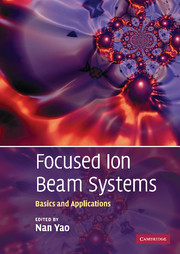Book contents
- Frontmatter
- Contents
- List of contributors
- Preface
- 1 Introduction to the focused ion beam system
- 2 Interaction of ions with matter
- 3 Gas assisted ion beam etching and deposition
- 4 Imaging using electrons and ion beams
- 5 Characterization methods using FIB/SEM DualBeam instrumentation
- 6 High-density FIB-SEM 3D nanotomography: with applications of real-time imaging during FIB milling
- 7 Fabrication of nanoscale structures using ion beams
- 8 Preparation for physico-chemical analysis
- 9 In-situ sample manipulation and imaging
- 10 Micro-machining and mask repair
- 11 Three-dimensional visualization of nanostructured materials using focused ion beam tomography
- 12 Ion beam implantation of surface layers
- 13 Applications for biological materials
- 14 Focused ion beam systems as a multifunctional tool for nanotechnology
- Index
- References
14 - Focused ion beam systems as a multifunctional tool for nanotechnology
Published online by Cambridge University Press: 12 January 2010
- Frontmatter
- Contents
- List of contributors
- Preface
- 1 Introduction to the focused ion beam system
- 2 Interaction of ions with matter
- 3 Gas assisted ion beam etching and deposition
- 4 Imaging using electrons and ion beams
- 5 Characterization methods using FIB/SEM DualBeam instrumentation
- 6 High-density FIB-SEM 3D nanotomography: with applications of real-time imaging during FIB milling
- 7 Fabrication of nanoscale structures using ion beams
- 8 Preparation for physico-chemical analysis
- 9 In-situ sample manipulation and imaging
- 10 Micro-machining and mask repair
- 11 Three-dimensional visualization of nanostructured materials using focused ion beam tomography
- 12 Ion beam implantation of surface layers
- 13 Applications for biological materials
- 14 Focused ion beam systems as a multifunctional tool for nanotechnology
- Index
- References
Summary
Introduction
In 1979, Dr. Seliger proposed the concept of the focused ion beam (FIB) using liquid-metal gallium as an ion source [1]. The FIB tool focuses ions generated from an ion source using an electric field, irradiates the ion beam on to specimen surfaces, and observes microscopic specimen surfaces by scanning. The scan region of the ion beam can be selectively sputter etched when ions heavier than electrons are used. A scanning electron microscope (SEM) can be used for observation or analysis, but FIB can be used for both observation and processing. Many research organizations and companies are now involved in FIB development.
The Scientific Instruments Division of Seiko Instruments Inc. (currently SII Nano Technology Inc.) started research and development at the beginning of the 1980s and developed a technology called ion beam induced chemical vapor deposition (CVD). This technology makes it possible to accumulate thin films.
In 1984 SII introduced the world's first FIB photo mask repair tool called the SIR series [2]. White defects, the shaded part of the photo mask used in making integrated circuits that falls off, are filled in and repaired by an ion beam induced CVD of carbon film. Later, there were advances in technical development [3], such as the capability to repair black defects left over from shading material in parts that transmit light, and precision processing that corresponds to a miniaturization of the design rules.
In 1986, SII introduced the world's first multi-purpose commercial FIB tool called the SMI series.
- Type
- Chapter
- Information
- Focused Ion Beam SystemsBasics and Applications, pp. 355 - 390Publisher: Cambridge University PressPrint publication year: 2007
References
- 2
- Cited by



